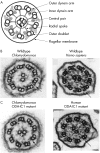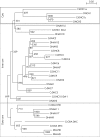Identification of predicted human outer dynein arm genes: candidates for primary ciliary dyskinesia genes
- PMID: 15937072
- PMCID: PMC2593024
- DOI: 10.1136/jmg.2005.033001
Identification of predicted human outer dynein arm genes: candidates for primary ciliary dyskinesia genes
Abstract
Background: Primary ciliary dyskinesia (PCD) is a severe inherited disorder characterised by chronic respiratory disease, male infertility, and, in approximately 50% of affected individuals, a left-right asymmetry defect called situs inversus. PCD is caused by defects in substructures of the ciliary and flagellar axoneme, most commonly loss of the outer dynein arms. Although PCD is believed to involve mutations in many genes, only three have been identified.
Methods: To facilitate discovery of new PCD genes, we have used database searching and analysis to systematically identify the human homologues of proteins associated with the Chlamydomonas reinhardtii outer dynein arm, the best characterised outer arm of any species.
Results: We find that 12 out of 14 known Chlamydomonas outer arm subunits have one or more likely orthologues in humans. The results predict a total of 24 human genes likely to encode outer dynein arm subunits and associated proteins possibly necessary for outer arm assembly, plus 12 additional closely related human genes likely to encode inner dynein arm subunits.
Conclusion: These genes, which have been located on the human chromosomes for easy comparison with known or suspected PCD loci, are excellent candidates for screening for disease-causing mutations in PCD patients with outer and/or inner dynein arm defects.
Conflict of interest statement
Competing interests: none declared
References
-
- Afzelius B, Mossberg B, Bergstrom S. Immotile cilia syndrome (primary ciliary dyskinesia), including Kartagener syndrome. In: Scriver C, Beaudet A, Sly W, Valle D, eds. The metabolic and molecular bases of inherited disease. New York: McGraw‐Hill, 20014817–4827.
-
- Meeks M, Bush A. Primary ciliary dyskinesia (PCD). Pediatr Pulmonol 200029307–316. - PubMed
-
- Olbrich H, Haffner K, Kispert A, Volkel A, Volz A, Sasmaz G, Reinhardt R, Hennig S, Lehrach H, Konietzko N, Zariwala M, Noone P G, Knowles M, Mitchison H M, Meeks M, Chung E M, Hildebrandt F, Sudbrak R, Omran H. Mutations in DNAH5 cause primary ciliary dyskinesia and randomization of left‐right asymmetry. Nat Genet 200230143–144. - PubMed
-
- Bartoloni L, Blouin J L, Pan Y, Gehrig C, Maiti A K, Scamuffa N, Rossier C, Jorissen M, Armengot M, Meeks M, Mitchison H M, Chung E M, Delozier‐Blanchet C D, Craigen W J, Antonarakis S E. Mutations in the DNAH11 (axonemal heavy chain dynein type 11) gene cause one form of situs inversus totalis and most likely primary ciliary dyskinesia. Proc Natl Acad Sci U S A 20029910282–10286. - PMC - PubMed
Publication types
MeSH terms
Substances
Grants and funding
LinkOut - more resources
Full Text Sources




